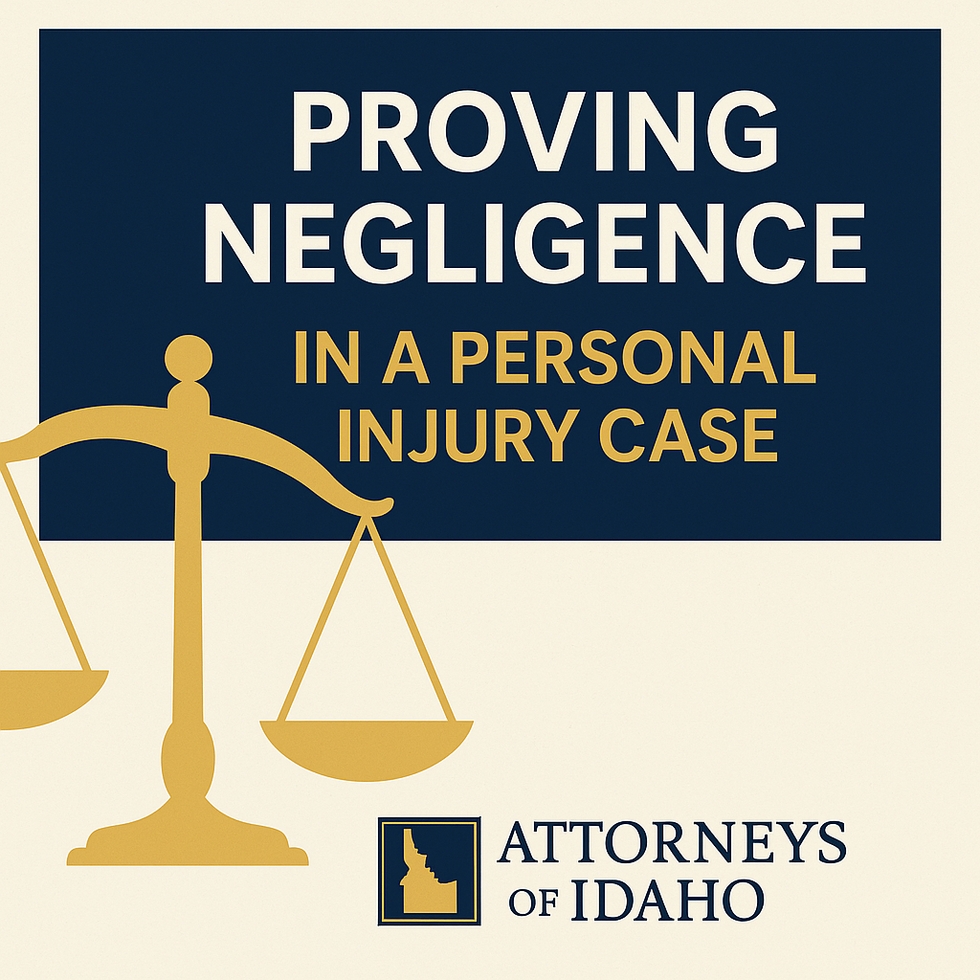
If you’ve been injured in an accident in Idaho—whether from a car crash, a slip and fall, or another incident—the foundation of your legal claim often comes down to one crucial concept: negligence. To receive compensation in a personal injury lawsuit, you must prove that another party’s carelessness or failure to act reasonably caused your injury. But what does that actually mean under Idaho law? And how do you go about proving it?
This post breaks down how negligence works in Idaho personal injury cases, the four key elements required to prove it, and the kinds of evidence you need to support your claim.
The Legal Definition of Negligence in Idaho
Negligence occurs when someone fails to exercise the level of care that a reasonably prudent person would under similar circumstances—and that failure causes harm to another person. Idaho follows a traditional four-element structure to determine whether negligence has occurred. You must prove:
- Duty of Care
- Breach of Duty
- Causation
- Damages
Each element must be established with evidence. If any one of these elements is missing, the claim may fail, no matter how serious the injury is.
1. Duty of Care
The first step is showing that the defendant owed you a duty of care. This is usually straightforward. For example:
- Drivers in Idaho have a duty to follow traffic laws and drive safely.
- Property owners must maintain reasonably safe conditions for lawful visitors.
- Dog owners are expected to control their animals to prevent harm.
In general, Idaho law recognizes that people have a legal responsibility to avoid putting others at unreasonable risk.
However, the exact nature of that duty depends on the relationship between the parties. For example, business owners owe a higher duty to customers than to trespassers under Idaho’s premises liability laws.
2. Breach of Duty
Once a duty is established, you must show that the defendant breached that duty—meaning they did something a reasonably careful person wouldn’t do in the same situation.
Examples of a breach in Idaho might include:
- Running a red light
- Failing to remove ice from a public sidewalk
- Leaving hazards in a store aisle without warning signs
- Allowing a dog to roam off-leash in violation of local ordinances
In legal terms, this means the person failed to act as a reasonable person would have. This is where most personal injury claims are won or lost—the question of whether the defendant’s actions were reasonable under the circumstances is often debated.
3. Causation
Proving a breach of duty isn’t enough. You also have to show that the breach caused your injury. Idaho law requires two types of causation:
- Actual cause (cause-in-fact): You wouldn’t have been injured “but for” the defendant’s actions.
- Proximate cause (legal cause): The injury was a foreseeable result of the defendant’s actions.
For example, if a speeding driver runs a stop sign and hits your car, their negligence (speeding and failing to stop) is both the actual and proximate cause of your injuries. But if something completely unrelated—like a medical error after the crash—causes further harm, that may complicate the question of causation.
4. Damages
Finally, you must demonstrate that you suffered actual damages. These may include:
- Medical expenses
- Lost income or earning potential
- Property damage
- Pain and suffering
- Emotional distress
- Permanent disability or disfigurement
In Idaho, you can’t sue just because someone did something wrong—you must have suffered a real, provable loss.
It’s important to keep detailed records of all expenses and impacts on your life. This not only supports your claim but also ensures you are compensated fairly for all aspects of your injury.
How Idaho’s Comparative Fault Law Affects Your Case
Idaho applies a modified comparative negligence rule (Idaho Code § 6-801). This means:
- If you are 50% or more at fault, you cannot recover damages.
- If you are less than 50% at fault, your compensation will be reduced by your percentage of fault.
For example, if you’re awarded $100,000 in damages but are found to be 25% at fault, your compensation would be reduced to $75,000.
This system makes it especially important to prove that the defendant was mostly or entirely responsible for the accident.
Common Types of Evidence Used to Prove Negligence
The strength of your claim will come down to the quality and quantity of your evidence. In Idaho personal injury cases, common types of evidence include:
- Police or accident reports
- Photographs or video footage of the accident scene
- Eyewitness testimony
- Medical records and bills
- Expert opinions (e.g., accident reconstruction, medical experts)
- Maintenance logs or incident reports (especially in premises liability cases)
- Cell phone records or surveillance footage
Because Idaho courts require that each element be proven by a preponderance of the evidence (i.e., more likely than not), thorough documentation is essential.
Final Thoughts
Proving negligence in an Idaho personal injury case requires careful attention to legal details and persuasive evidence. While the concept may seem straightforward, each case hinges on facts, context, and how clearly you can show that the other party failed to act reasonably and caused your injury.
Whether your injury came from a vehicle accident in Boise, a fall in a Coeur d’Alene business, or a dog bite in Pocatello, the legal principles are the same—but the outcome depends on how well you can prove your case.
If you’ve been hurt and believe someone else is responsible, start gathering evidence immediately and make sure you understand each of the four legal elements. Negligence law in Idaho is precise, and your success depends on how well you meet the standard.

